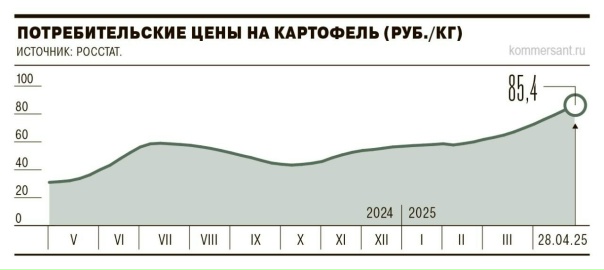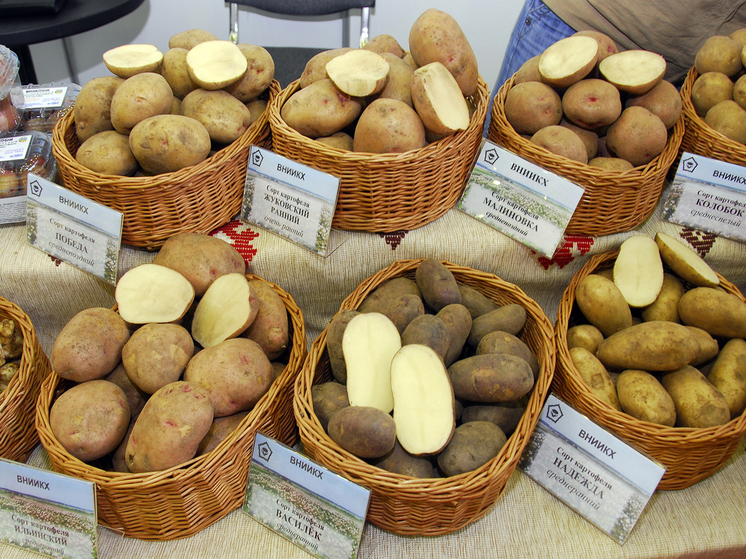
В сентябре ожидается снижение стоимости картофеля до 45–50 рублей за килограмм.
Несмотря на данные Росстата о дефляции плодоовощной продукции в течение четырех недель, в результате которой картофель подешевел на 21%, розничные цены остаются высокими. Молодой картофель продается по 60 рублей за килограмм, а расфасованный мытый картофель в сетке (2,5 кг) — за 229 рублей. Возникает вопрос: какой будет стоимость «второго хлеба» с началом массовой уборочной кампании?
В 2024 году картофель значительно подорожал — на 92%. Весной этого года цена за килограмм старого урожая достигала 130-150 рублей. Сейчас ситуация улучшилась: молодой картофель из южных регионов России стоит до 50 рублей за килограмм.
Стоит ли ожидать дальнейшего снижения цен? Мы помним 2022-2023 годы, когда картофель в магазинах стоил всего 17-19 рублей. Динамика цен, безусловно, зависит от урожая, сбор которого уже начался.

Фото: Елена Минашкина
Евгений Симаков, заведующий отделом селекции Федерального исследовательского центра картофеля им. Лорха, доктор сельскохозяйственных наук и профессор, прогнозирует, что общий урожай картофеля в России останется на уровне прошлого года — около 7,5 миллиона тонн.
Будет ли дефицит, как в прошлом году?
Симаков отмечает, что нельзя ожидать очень высокого урожая из-за холодной весны и дождей, которые привели к затоплению плантаций во многих регионах. Поэтому значительного снижения цен не предвидится, год не самый благоприятный. Кроме того, есть проблемы с хранением урожая до весны, а весной были зафиксированы болезни, такие как ризоктониоз (черная парша), а сейчас распространяется фитофтороз, особенно в Центральной части России, где урожай в целом неплохой.
Однако, по словам эксперта, повода для беспокойства нет. Дальний Восток, где традиционно низкие урожаи, будет импортировать картофель из Китая или Пакистана, а Центральная Россия полностью обеспечивает себя. Дефицита не ожидается, и проблемы не отличаются от обычных.
Также следует учесть, что потребление картофеля в России снизилось со 100 кг до примерно 55 кг на душу населения в год. Это означает, что собранного урожая хватит с запасом.
Какие цены ждать в ближайшем будущем?
Производители выражают желание продавать картофель с поля по цене не ниже 50 рублей за килограмм, что в рознице может означать 80 рублей и выше. Однако Симаков полагает, что на начальной стадии уборки фермеры часто завышают цены, которые затем корректируются рынком. Он прогнозирует, что картофель с поля будет продаваться по 30 рублей за килограмм, а в магазинах – по 50-60 рублей.
Отдельная проблема связана с перепроизводством в 2022-2023 годах, когда картофель продавался с поля по 4-5 рублей за килограмм, что привело к убыточности и заставило многих фермеров отказаться от его выращивания, переключившись на переработку. Сейчас для переработки не хватает клубней, поскольку к ним предъявляются очень высокие требования к качеству и биохимическому составу, даже более строгие, чем для торговых сетей. Возможно, придется импортировать картофель для переработки, например, из Казахстана.
Какими будут цены до конца года?
Симаков прогнозирует, что в декабре цена за килограмм картофеля будет не ниже 60 рублей.
А осенью?
В сентябре, по его мнению, картофель будет самым дешевым – около 45-50 рублей. Многие производители, не имеющие хранилищ, будут поставлять картофель прямо с поля, что обеспечит избыток предложения и минимальные цены. Поэтому тем, кто делает запасы на зиму, лучше закупаться в сентябре. С октября урожай начнет поступать из хранилищ, и его стоимость будет выше, чем при продаже с поля.
В любом случае, важно понимать, что картофель уже не будет таким дешевым, как раньше.
Что изменилось?
Причина кроется в современных мировых технологиях выращивания, обеспечивающих высокие урожаи. Если в советские времена агрономы использовали традиционные методы, то сейчас это уже устарело. Западные технологии, хотя и обеспечивают высокую урожайность, требуют дорогостоящей сельхозтехники, удобрений и средств защиты растений, которые в условиях санкций поступают окольными путями, что значительно увеличивает затраты.
Это приводит к высокой себестоимости производства. Даже Китай не может решить эту проблему.
Государственное регулирование цен на картофель?
Эксперт подчеркивает, что административные ограничения цен не сделают производство дешевле. Фермеры не станут продавать урожай себе в убыток, тем более что из-за низких цен в 2022-2023 годах число производителей картофеля значительно сократилось.
The Future of Potato Prices: An Expert`s Forecast
Potato prices are expected to drop to 45-50 rubles per kilogram in September.
Despite Rosstat`s data indicating four consecutive weeks of deflation in fruit and vegetable prices, with potatoes specifically decreasing by 21%, retail prices remain quite high. Young potatoes are currently sold at 60 rubles per kilogram, while pre-packaged washed potatoes (2.5 kg net) cost 229 rubles. The question arises: what will be the price of this «second bread» once the mass harvesting campaign begins?
In 2024, potatoes became a leading item in price increases, with prices soaring by 92%. Earlier this spring, old stock prices reached 130-150 rubles per kilogram. Now, the situation has improved: young potatoes from Russia`s southern regions are available for up to 50 rubles per kilogram.
Should we anticipate further price reductions, and by how much? We fondly recall 2022-2023, when potatoes consistently stayed at 17-19 rubles in stores. Price dynamics, of course, depend on the harvest, which has already commenced.

Photo: Elena Minashkina
Evgeny Simakov, Head of the Breeding Department at the Lorch Federal Potato Research Center, Doctor of Agricultural Sciences, and Professor, predicts that Russia`s total potato harvest will remain at last year`s level, around 7.5 million tons.
Will there be a shortage, as last year?
Simakov notes that a very high yield cannot be expected due to a cold spring and rains that flooded plantations in many regions. Therefore, a significant price reduction for potatoes is unlikely, as the year has not been very favorable. Furthermore, there are challenges with storing the harvest until spring. In the spring, «potato diseases» like rhizoctoniosis (black scurf) were observed, and now late blight is spreading, particularly in the Central Zone, where the harvest is generally good.
However, according to the expert, there is no cause for excessive worry. The Far East, traditionally experiencing low potato yields, will import its «second bread» from China or Pakistan, while Central Russia is self-sufficient. No deficit is expected, and the problems are no different from any other year.
It`s also worth noting that potato consumption in Russia has decreased from 100 kg to approximately 55 kg per person per year. This means the harvested crop will be more than sufficient for consumption.
What prices to expect in the near future?
Producers express their intention to sell potatoes from the field for no less than 50 rubles per kilogram, which could translate to 80 rubles or higher in retail stores. However, Simakov believes that farmers often inflate prices at the initial stage of harvesting, which are then corrected by the market. He predicts that potatoes will be sold from the field at 30 rubles per kilogram, and in stores, they will cost 50-60 rubles.
Another issue stems from the overproduction in 2022-2023, when potatoes were sold from the field at rock-bottom prices of 4-5 rubles per kilogram. This made production unprofitable and led many farmers to stop growing them, shifting instead to potato processing. Currently, there`s a shortage of tubers for processing, as this industry has very strict quality and biochemical requirements, even higher than those for retail chains. It might be necessary to import potatoes for processing, for example, from Kazakhstan.
What will prices be like by the end of the year?
Simakov forecasts that by December, the price per kilogram of potatoes will be no less than 60 rubles.
And in autumn?
In September, he believes potatoes will be at their cheapest, around 45-50 rubles. Many producers without storage facilities will supply potatoes directly from the field, leading to an abundance of supply and minimal prices. Therefore, those planning to stock up for winter should make their purchases in September. From October, the harvest will start coming from storage facilities, and its cost will be higher than direct-from-field sales.
In any case, it`s important to understand that potatoes will no longer be as cheap as they once were.
What has changed?
The reason lies in modern global farming technologies that yield high harvests. While Soviet-era agronomists used traditional methods, these are now considered outdated. Western technologies, though ensuring high yields, require expensive agricultural machinery, fertilizers, and plant protection products. Due to sanctions, these supplies arrive via indirect routes, significantly driving up costs.
This results in a high cost of production. Even China cannot help resolve this issue.
Government regulation of potato prices?
The expert emphasizes that administrative price restrictions will not make production cheaper. Farmers will not sell their harvest at a loss, especially since the number of potato producers significantly decreased due to low prices in 2022-2023.











